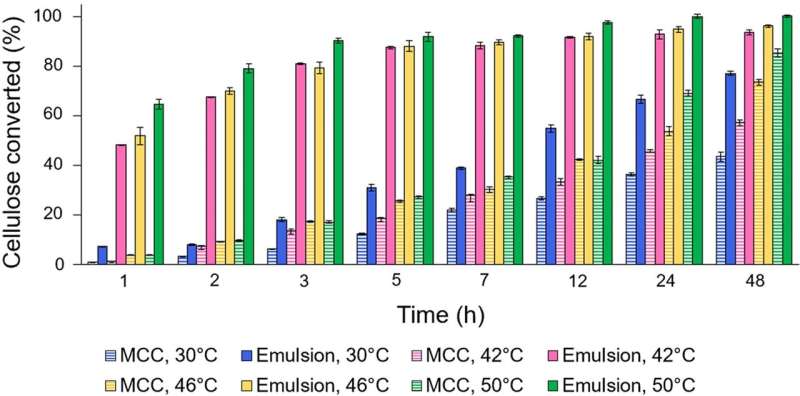New platform speeds up effort to turn crops into fuel

Princeton researchers have developed a new way to make fuel from cellulose—Earth's most abundant organic compound, found in all plant cells—speeding up a notoriously slow chemical process and in some cases doubling energy yields over comparable methods.
Their platform uses a recently developed cellulose emulsion that makes it easier to metabolize the compound into other chemicals. Combining that emulsion with engineered microbes and a light-based genetic tool, the team showed that they could more efficiently make biofuels from cellulose.
A paper published July 17 in the journal Biotechnology for Biofuels demonstrates the platform's performance with both ethanol, the current leading biofuel, and isobutanol, a biofuel that improves on ethanol as a drop-in gasoline replacement and can also provide the base for jet fuel. In both cases, the new method substantially improved speeds of production and yields compared to untreated cellulose.
"The main challenge is that cellulose is very hard to process. It first has to be broken down into individual sugar molecules before it can be turned into fuel," said Shannon Hoffman, a graduate student in chemical and biological engineering and one of the study's lead authors. "Our paper shows a new and more effective way to break down the cellulose for use in biofuel production."
Cellulosic biomass has long been seen as a key ingredient in curbing greenhouse gas emissions, providing the feedstock for a renewable and clean-burning transportation fuel. The U.S. Department of Energy has conducted a series of studies showing that at least one billion tons of biomass could be sustainably harvested each year in the United States without disrupting forests or food production to produce biofuels, largely from cellulose. But current processes that convert that cellulose to simple sugars for fuel production have faced economic challenges, due in part to slow conversion rates and inefficiencies.
This study shows a new approach. Instead of starting with cellulose crystals, the team started with emulsions of pre-treated cellulose, recently developed at the Technion-Israel Institute of Technology. The emulsion makes it easier for enzymes to break tough cellulose chains into single glucose molecules and simultaneously feed that glucose to genetically engineered yeast for fermentation. And using light, the team controlled the yeasts' output, switching between metabolic pathways to optimize for the desired product.
In the first hour of cellulose digestion, their platform worked around 40 times faster than the untreated crystal cellulose. With isobutanol, it was up to four times faster overall and twice as productive.
While this study doesn't address all impediments to commercial viability, the results demonstrate a promising new direction in the quest to make advanced biofuels from dedicated energy crops and agricultural residues such as the stubble left in a field after harvest.
"If we want to reach the Paris Agreement goals of keeping global warming below 1.5 °C, we need to reach carbon neutrality by 2050. Even with optimistic electrification rates of cars and trucks, there's a gap to eliminate fossil fuels from transportation in that time period," said the study's principal investigator José Avalos, assistant professor of chemical and biological engineering and the Andlinger Center for Energy and the Environment. "We're going to need a sustainable, low carbon-emissions fuel to fill that gap. And then there are of course airplanes, which we don't expect we'll be able to electrify by 2050. So we are going to need sustainable biofuels for the foreseeable future."
More information: Shannon M. Hoffman et al, Cellulosic biofuel production using emulsified simultaneous saccharification and fermentation (eSSF) with conventional and thermotolerant yeasts, Biotechnology for Biofuels (2021). DOI: 10.1186/s13068-021-02008-7
Journal information: Biotechnology for Biofuels
Provided by Princeton University



















